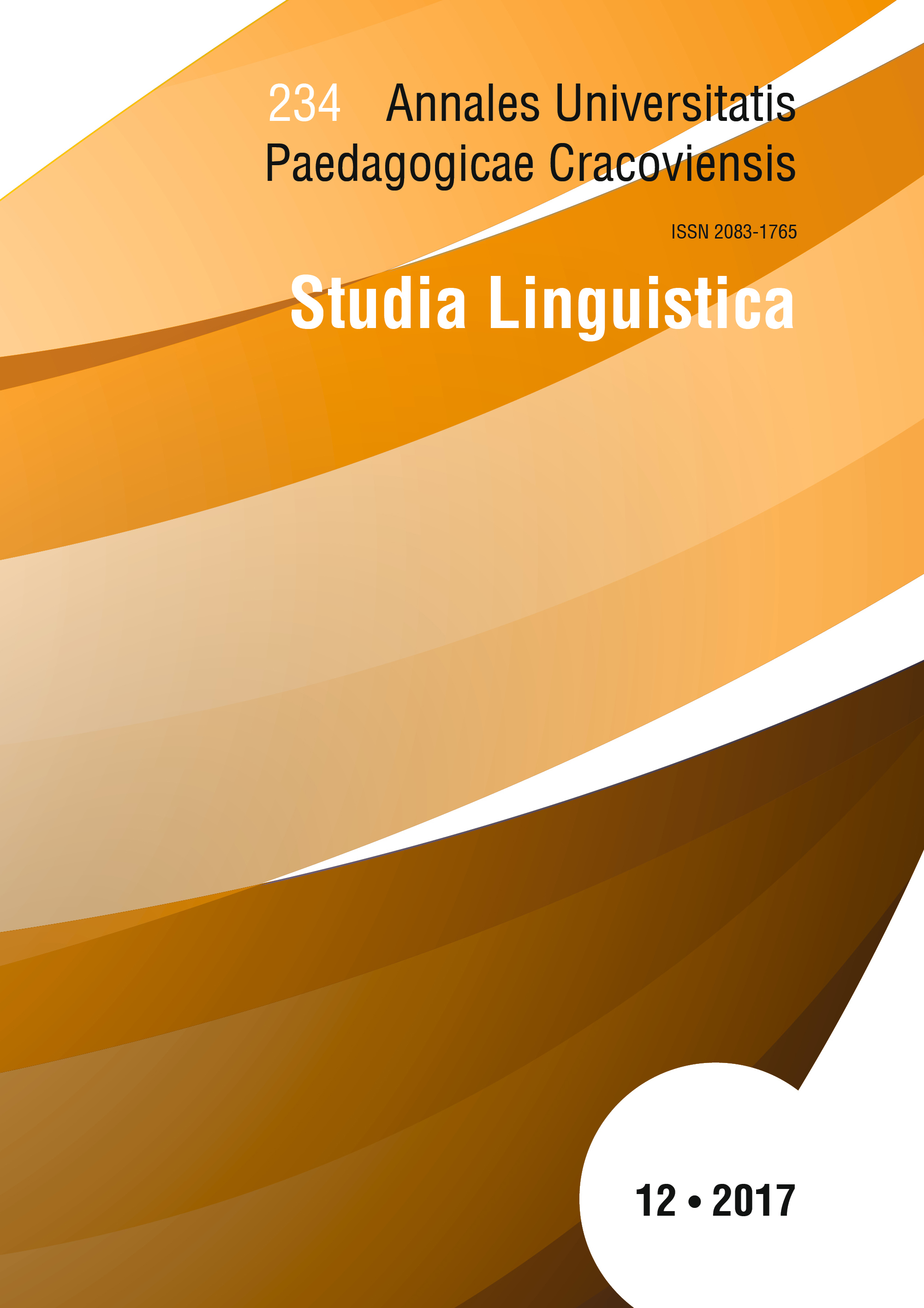Obraz narzędzi rolniczych utrwalony w polskiej frazeologii i paremiologii
Main Article Content
Abstrakt
The object of analysis in this paper are fixedword combinations (phraseological units and proverbs) with components denoting names of agricultural tools. They were used to conceptualize numerous ideas connected not only with the appearance of tools and agricultural work done, but also with various aspects of individual and collective life. Most of the analysed phrasemes already belong to the recessive sphere of phraseology. In order to understand them completely, it is necessary to have some knowledge of what they look like, what purpose they served and what kind of work was done with their use, which is not always clear to people who don’t know anything about the village reality.
Downloads
Article Details
Autor, zgłaszając tekst do redakcji czasopisma „Annales Universitatis Paedagogicae Cracoviensis. Studia Linguistica”, zaświadcza, iż jest on rezultatem wyłącznie jego własnej twórczości, że treść artykułu nie była dotychczas publikowana oraz że utwór nie narusza w żadnym stopniu praw autorskich ani praw pokrewnych innych osób, jak również innych praw osób trzecich, a także, że niczyje prawa do utworu (lub jego jakiejkolwiek części) nie zostały pominięte. Po podpisaniu umowy prawa majątkowe do opublikowanych materiałów zostają przeniesione na Wydawnictwo Naukowe Uniwersytetu Komisji Edukacji Narodowej w Krakowie.
Rocznik „Annales Universitatis Paedagogicae Cracoviensis. Studia Linguistica” to czasopismo o otwartym dostępie, a cała jego zawartość jest udostępniana bezpłatnie dla użytkowników i instytucji na zasadach licencji Creative Commons CC-BY-NC-ND 4.0 (uznanie autorstwa, użycie niekomercyjne, bez utworów zależnych). Na podstawie tej licencji autorzy zgadzają się, że ich prace mogą być zgodnie z prawem ponownie wykorzystywane do jakichkolwiek celów, za wyjątkiem celów komercyjnych, bez konieczności uzyskania uprzedniej zgody ze strony autora lub wydawcy. Każdy może prace te czytać, pobierać, kopiować, drukować, rozpowszechniać oraz przetwarzać, pod warunkiem poprawnego oznaczenia autorstwa oraz oryginalnego miejsca publikacji. Publikowanych tekstów nie można wykorzystywać do tworzenia utworów zależnych (np. do tłumaczenia ich i publikowania w innym języku bez zgody wydawcy). Jest to zgodne z definicją otwartego dostępu BOAI (Budapest Open Access Initiative) „Studia Linguistica”nie pobiera opłat za składanie artykułów ani ich przetwarzanie.
Autor, przesyłając artykuł do redakcji „Studia Linguistica”, bezwględnie zgadza się z poniższymi punktami:
-
Oświadczam, że jestem Autorem lub Współautorem nadesłanego tekstu. Przesłany tekst nie był nigdzie publikowany, jest całkowicie oryginalny i nie narusza w żadnym stopniu praw autorskich ani praw pokrewnych innych osób, jak również innych praw osób trzecich, a także, że niczyje prawa do utworu nie zostały pominięte.
-
Oświadczam, że nadesłany tekst nie został złożony do recenzji lub/i publikacji w innym czasopiśmie.
-
Przyjmuję do wiadomości, że Autor ponosi pełną odpowiedzialność za każdy przypadek plagiatu, niezależnie od tego, czy został on wykryty podczas procesu recenzji, czy po publikacji w „Studia Linguistica”.
-
Oświadczam, że ponoszę pełną odpowiedzialność finansową i prawną za wszelkie roszczenia związane z utworem.
-
Potwierdzam uznanie wszystkich źródeł danych wykorzystanych i cytowanych w badaniach.
-
Potwierdzam, że artykuł został wykonany z należytą starannością zgodnie ze standardami edytorskimi „Studia Linguistica”.
Bibliografia
Bartmiński J., 2006, Językowe podstawy obrazu świata, Lublin.
Google Scholar
Grzegorczykowa R., Puzynina J., 1984, Słowotwórstwo rzeczowników, [w:] Gramatyka współczesnego języka polskiego. Składnia – Morfologia – Fonologia, red. naukowy S. Urbańczyk; t. 2, R. Grzegorczykowa, K. Kallas, K. Kowalik, R. Laskowski, A. Orzechowska, J. Puzynina, H. Wróbel, Morfologia, s. 332–407.
Google Scholar
Grzegorczykowa R., Szymanek B., 1993, Kategorie słowotwórcze w perspektywie kognitywnej, [w:] Współczesny język polski, red. J. Bartmiński, Wrocław, s. 458–474.
Google Scholar
Jaros I., 2009, Nazwy środków czynności w gwarach łęczycko-sieradzkich. Studium słowotwórczo-leksykalne, Łódź.
Google Scholar
Koziara S., 2001, Frazeologia biblijna w języku polskim, Kraków.
Google Scholar
Kucała M., 1957, Porównawczy słownik trzech wsi małopolskich, Wrocław.
Google Scholar
Markowski A., 1992, Leksyka wspólna różnym odmianom polszczyzny, Warszawa.
Google Scholar
Młynarczyk E., 2014, Obraz narzędzi rękodzielniczych w polskich frazeologizmach i przysłowiach, „Annales Universitatis Paedagogicae Cracoviensis. Studia Linguistica” IX, s. 30–39.
Google Scholar
Młynarczyk E., 2015, Nazwy narzędzi jako podstawa metonimicznego obrazowania w przysłowiach i w swobodnych połączeniach wyrazowych, [w:] Linguo-cultural research on phraseology, red. J. Szerszunowicz i in., Białystok, s. 225–238.
Google Scholar
Skorupka S., 1969, Podstawy klasyfikacji jednostek frazeologicznych, „Prace Filologiczne”, t. XIX, s. 219–226.
Google Scholar
Wyszyński S., 1956, Jasnogórskie Śluby Narodu Polskiego, http://www.wyszynski.psur. pl/sluby.php (dostęp: 31.05.2017).
Google Scholar
